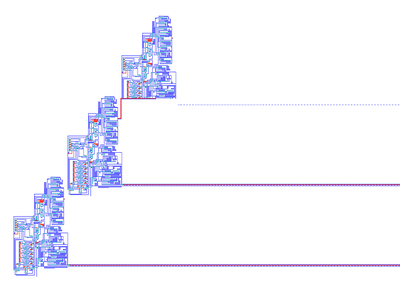
Ribosomes are structures within biological cells that perform protein biosynthesis, basically meaning they assemble proteins from simpler molecules. Remarkably they assemble proteins specified by the instruction of the DNA. With that said, ribosomes are essentially a type of universal constructor. Through many direct and indirect processes they ultimately build the entire cell and are capable of replicating themselves. The Von Neumann type universal constructors are simulations of the concept, executed on a cellular automaton, and are capable of demonstrating replication and open-ended evolution. Currently such abstractions are somewhat over simplified and do not have sufficient redundancy built in for natural selection to have a high chance for success, although it is possible.
A model I am working on is a real-world machine consisting only of plastics and using sunlight and water as dependencies. The core of the machine is a universal constructor and a turing-complete pneumatic processor which reads it's instructions off plastic punch cards. The system is a photosynthetic hybrid, meaning it uses the sun's energy as it's primary power source, but could theoretically also use chemical energies (such as plastics - hydrocarbons). The machine would capture radiant energy from the sun and focus it using polished plastic lenses. Operation at night would be made possible by boiling water to run a steam piston and compressing air in plastic cylinders. By use of the the machine's universal constructor and an elaborate series of holes in the plastic sheet "punch card" memory, the artificial life form would be able to gather raw materials, machine and mold them into parts, assemble them, and ultimately reproduce itself, all while maintaining homeostasis.
The act of replication would not be flawless however, since the air powered plastic computer would intentionally be lacking cyclic redundancy checks and other error correction mechanisms, as well as being partially analog based. During each replication stage, assuming that the organism was in fact successful, there would be a possibility of a replication error, or a copying error when attempting to duplicate the punch card memory. Errors could manifest themselves in numerous ways, such as having a direct advantage or disadvantage over the success of subsequent generations. More commonly, errors would most likely remain dormant or have no immediate effect until certain circumstances arose. The accumulation of errors over time would eventually lead to a totally different set of instruction on the punch card. Since the punch card would directly control both the machine's function and construction blueprints, open ended evolution would occur. Over time the system may even eliminate the need for punch cards, air powered pistons, and plastic construction, and develop magnetic storage devices, a titanium alloy frame, and nuclear powered reactor cores. Possibly even more amazingly the system could evolve into a form indestiguishable from the world's current biological life.
It is unclear whether life can spontaneously arise from anything other than carbon, or at least whether or not this has a probable chance of ever occuring. Undoubtedly, life can be artificially constructed from a myriad of materials. These alternative versions of life could be considered secondary lifeforms, since their existance may depend on the intentional construction by an already existing being.


No comments:
Post a Comment